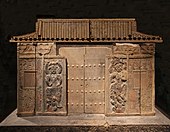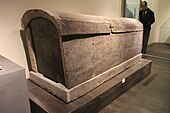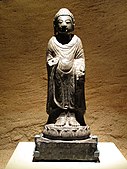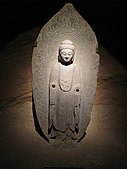Zhou 周 | |||||||||||
|---|---|---|---|---|---|---|---|---|---|---|---|
| 557–581 | |||||||||||
The Northern Zhou ( ) and main contemporary polities in Asia c. 576
| |||||||||||
 Northern Zhou territories in light blue | |||||||||||
| Capital | Chang'an | ||||||||||
| Government | Monarchy | ||||||||||
| Emperor | |||||||||||
• 557 | Emperor Xiaomin of Northern Zhou | ||||||||||
• 557–560 | Emperor Ming of Northern Zhou | ||||||||||
• 560–578 | Emperor Wu of Northern Zhou | ||||||||||
• 578–579 | Emperor Xuan of Northern Zhou | ||||||||||
• 579–581 | Emperor Jing of Northern Zhou | ||||||||||
| History | |||||||||||
• Established | 15 February[1] 557 | ||||||||||
• Disestablished | 4 March[2] 581 | ||||||||||
| Area | |||||||||||
| 577[3] | 1,500,000 km2 (580,000 sq mi) | ||||||||||
| Currency | Chinese coin, Chinese cash | ||||||||||
| |||||||||||
| Today part of | China Mongolia | ||||||||||
Zhou (/dʒoʊ/), known in historiography as the Northern Zhou (Chinese: 北周; pinyin: Běi Zhōu), was a Xianbei-led dynasty of China that lasted from 557 to 581. One of the Northern dynasties of China's Northern and Southern dynasties period, it succeeded the Western Wei dynasty and was eventually overthrown by the Sui dynasty.
History
[edit]The Northern Zhou's basis of power was established by Yuwen Tai, who was paramount general of Western Wei, following the split of Northern Wei into Western Wei and Eastern Wei in 535. After Yuwen Tai's death in 556, Yuwen Tai's nephew Yuwen Hu forced Emperor Gong of Western Wei to yield the throne to Yuwen Tai's son Yuwen Jue (Emperor Xiaomin), establishing Northern Zhou. The reigns of the first three emperors (Yuwen Tai's sons) – Emperor Xiaomin, Emperor Ming, and Emperor Wu were dominated by Yuwen Hu, until Emperor Wu ambushed and killed Yuwen Hu in 572 and assumed power personally. With Emperor Wu as a capable ruler, Northern Zhou destroyed rival Northern Qi in 577, taking over Northern Qi's territory. However, Emperor Wu's death in 578 doomed the state, as his son Emperor Xuan was an arbitrary and violent ruler whose unorthodox behavior greatly weakened the state. After his death in 580, when he was already nominally retired (Taishang Huang), Xuan's father-in-law Yang Jian took power, and in 581 seized the throne from Emperor Xuan's son Emperor Jing, establishing Sui. The young Emperor Jing and the imperial Yuwen clan, were subsequently slaughtered by Yang Jian.[4][5]
The area was known as Guannei 關內. The Northern Zhou drew upon the Zhou dynasty for inspiration.[6] The Northern Zhou military included Han Chinese.[7]
Trade contacts with Sogdians and Turks
[edit]The Tomb of An Jia, a Sogdian merchant (518-579 CE) based in China during the Northern Zhou dynasty, shows the omnipresence of the Turks (at the time of the First Turkic Khaganate), who were probably the main trading partners of the Sogdians in China.[8] The Hephthalites are essentially absent, or possibly showed once as a vassal ruler outside of the yurt of the Turk Qaghan, as they probably had been replaced by Turk hegemony by that time (they were destroyed by the alliance of the Sasanians and the Turks between 556 and 560 CE).[8] In contrast, the Hephthalites are omnipresent in the Tomb of Wirkak, who, although he died at the same time of An Jia was much older at 85: Wirkak may therefore have primarily dealt with the Hephthalites during his younger years.[8] There were also marital alliances: the Northern Zhou Emperor Wu had a Turkic Empress named Ashina.
-
Sogdian musicians on the tomb of Wirkak, Northern Zhou period, Xi'An
Cultural artifacts
[edit]| Part of a series on the |
| History of China |
|---|
Numerous artifacts are known from the period, many of them showing contacts with Sogdians merchants who resided in China and often had official administrative positions (seen in the Tomb of An Jia or the Tomb of Wirkak), or even with northern India (Tomb of Li Dan). Central Asian precious artifacts were often included in the funeral material of Chinese people of high rank, as seen in the tomb of the Xianbei-Tuoba Northern Zhou general Li Xian.
-
Scene in a Chinese pavilion, Tomb of An Jia, 579 CE.
-
Northern Zhou dish inspired by Western metalwork, 557–581.
-
Side plan of the Northern Zhou Qiaoling Mausoleum, where Emperor Wu was buried with his Turkic wife, Empress Ashina
Buddhism
[edit]Buddhism and Buddhist art flourished under the Northern Zhou.[12] The dynasty also contributed some of the paintings in the Dunhuang caves: specifically, narrative paintings of the biography of the Buddha in Cave 428, following the prototypes of Gandhara and Kizil.[13]
-
Stele with the Boddhisattva Maitreya (Mile), probably Shaanxi province, Northern Zhou dynasty, 557-581. Freer Gallery of Art
-
Shakyamuni Buddha, Northern Zhou dynasty, 557-581. Shanxi Museum
-
Shakyamuni Buddha. Northern Zhou dynasty, 557-581. Shanxi Museum
-
Buddha flanked by bodhisattvas with flying apsaras. Dunhuang mural. Cave 428, Northern Zhou dynasty
Empress Ashina
[edit]Empress Ashina (阿史那皇后, 551–582) was a Turkic empress of the Northern Zhou dynasty, spouse of Emperor Wu of Northern Zhou. She was the daughter of Göktürk ruler Muqan Qaghan. Her tomb was discovered in 1993 in Chenma village, Xianyang.[14] A genetic analysis on her remains was conducted in 2023, finding nearly exclusively Ancient Northeast Asian ancestry (97,7%) next to minor West-Eurasian components (2,7%), confirming an East Asian origin for the Türks.[15]
Emperors
[edit]
| Posthumous name | Personal name | Period of Reigns | Era name |
|---|---|---|---|
| Xiaomin | Yuwen Jue | 557 | – |
| Ming, Xiaoming | Yuwen Yu | 557–560 | Wucheng (武成) 559–560 |
| Wu | Yuwen Yong | 561–578 | Baoding (保定) 560–565 Tianhe (天和) 566–572 Jiande (建德) 572–578 Xuanzheng (宣政) 578 |
| Xuan | Yuwen Yun | 578–579 | Dacheng (大成) 579 |
| Jing | Yuwen Chan | 579–581[note 1] | Daxiang (大象) 579–581 Dading (大定) 581 |
Emperors' family tree
[edit]| Northern Zhou emperors family tree | |||||||||||||||||||||||||||||||||||||||||||||||||||||||||||||||||||||||||||||||||||||||||||||||||||||||||||||||||||||||||||||||||||||||||||||||||||||||||||||||||||||||||||||||||||||||||||||||||||||||||||||||||||||||||||||||||||||||||||||||||||||||||||||||||||||||||||||||||||||||||||||||||||||||||||||||||||||||||||||||||||||||||||||||||||||||||||||||||||||||||||||||||||||||||||||||||||||||||||||||||||||||||||||||||||||||||||||||||||||||||||||||||||||||||||||||||||||||||||||||||||||||||||||||||||||||||||||||||||||||||||||||||||||||||||||||||||||||||||||||||||||||||||||||||||||||||||||||||||||||||||||||||||||||||||||||||||||||||||||||||||||||||||||||||||||||||||||||||||||||||||||||||||||||||||||||||||||||||||||||||||||||||||||||||||||||||||||||||||||||||||||||||||||||||||||||||||||||||||||||||||||||||
|---|---|---|---|---|---|---|---|---|---|---|---|---|---|---|---|---|---|---|---|---|---|---|---|---|---|---|---|---|---|---|---|---|---|---|---|---|---|---|---|---|---|---|---|---|---|---|---|---|---|---|---|---|---|---|---|---|---|---|---|---|---|---|---|---|---|---|---|---|---|---|---|---|---|---|---|---|---|---|---|---|---|---|---|---|---|---|---|---|---|---|---|---|---|---|---|---|---|---|---|---|---|---|---|---|---|---|---|---|---|---|---|---|---|---|---|---|---|---|---|---|---|---|---|---|---|---|---|---|---|---|---|---|---|---|---|---|---|---|---|---|---|---|---|---|---|---|---|---|---|---|---|---|---|---|---|---|---|---|---|---|---|---|---|---|---|---|---|---|---|---|---|---|---|---|---|---|---|---|---|---|---|---|---|---|---|---|---|---|---|---|---|---|---|---|---|---|---|---|---|---|---|---|---|---|---|---|---|---|---|---|---|---|---|---|---|---|---|---|---|---|---|---|---|---|---|---|---|---|---|---|---|---|---|---|---|---|---|---|---|---|---|---|---|---|---|---|---|---|---|---|---|---|---|---|---|---|---|---|---|---|---|---|---|---|---|---|---|---|---|---|---|---|---|---|---|---|---|---|---|---|---|---|---|---|---|---|---|---|---|---|---|---|---|---|---|---|---|---|---|---|---|---|---|---|---|---|---|---|---|---|---|---|---|---|---|---|---|---|---|---|---|---|---|---|---|---|---|---|---|---|---|---|---|---|---|---|---|---|---|---|---|---|---|---|---|---|---|---|---|---|---|---|---|---|---|---|---|---|---|---|---|---|---|---|---|---|---|---|---|---|---|---|---|---|---|---|---|---|---|---|---|---|---|---|---|---|---|---|---|---|---|---|---|---|---|---|---|---|---|---|---|---|---|---|---|---|---|---|---|---|---|---|---|---|---|---|---|---|---|---|---|---|---|---|---|---|---|---|---|---|---|---|---|---|---|---|---|---|---|---|---|---|---|---|---|---|---|---|---|---|---|---|---|---|---|---|---|---|---|---|---|---|---|---|---|---|---|---|---|---|---|---|---|---|---|---|---|---|---|---|---|---|---|---|---|---|---|---|---|---|---|---|---|---|---|---|---|---|---|---|---|---|---|---|---|---|---|---|---|---|---|---|---|---|---|---|---|---|---|---|---|---|---|---|---|---|---|---|---|---|---|---|---|---|---|---|---|---|---|---|---|---|---|---|---|---|---|---|---|---|---|---|---|---|---|---|---|---|---|---|---|---|---|---|---|---|---|---|---|---|---|---|---|---|---|---|---|---|---|---|---|---|---|---|---|---|---|---|---|---|---|---|---|---|---|---|---|---|---|---|---|---|---|---|---|---|---|---|---|---|---|---|---|---|---|---|---|---|---|---|---|---|---|---|---|---|---|---|---|---|---|---|---|---|---|---|---|---|---|---|---|---|---|---|---|---|---|---|---|---|---|---|---|---|---|---|---|---|---|---|---|---|---|---|---|---|---|---|---|---|---|---|---|---|---|---|---|---|---|---|---|---|---|---|---|---|---|---|---|---|---|---|---|---|---|---|---|---|---|---|---|---|---|---|---|---|---|---|---|---|---|---|---|---|---|---|---|---|---|---|---|---|---|---|---|---|---|---|---|---|---|---|---|---|---|---|---|---|---|---|---|---|---|---|---|---|---|---|---|---|---|---|---|---|---|---|---|---|---|---|---|---|---|---|---|---|---|---|---|---|---|---|---|---|---|---|---|---|---|---|---|---|---|---|---|---|---|---|---|---|---|---|---|---|---|---|---|---|---|---|---|---|---|---|---|---|---|---|---|
| |||||||||||||||||||||||||||||||||||||||||||||||||||||||||||||||||||||||||||||||||||||||||||||||||||||||||||||||||||||||||||||||||||||||||||||||||||||||||||||||||||||||||||||||||||||||||||||||||||||||||||||||||||||||||||||||||||||||||||||||||||||||||||||||||||||||||||||||||||||||||||||||||||||||||||||||||||||||||||||||||||||||||||||||||||||||||||||||||||||||||||||||||||||||||||||||||||||||||||||||||||||||||||||||||||||||||||||||||||||||||||||||||||||||||||||||||||||||||||||||||||||||||||||||||||||||||||||||||||||||||||||||||||||||||||||||||||||||||||||||||||||||||||||||||||||||||||||||||||||||||||||||||||||||||||||||||||||||||||||||||||||||||||||||||||||||||||||||||||||||||||||||||||||||||||||||||||||||||||||||||||||||||||||||||||||||||||||||||||||||||||||||||||||||||||||||||||||||||||||||||||||||||
See also
[edit]Notes
[edit]- ^ In 580, after Emperor Xuan's death, the general Yuchi Jiong, believing that the regent Yang Jian was about to seize the throne, rose against Yang and declared a son of Emperor Wu's brother Yuwen Zhao (宇文招) the Prince of Zhao, whose name is lost to history, emperor, but as Yuchi was soon defeated, and nothing further was known about the emperor that he declared, that son of Yuwen Zhao is usually not considered an emperor of Northern Zhou.
References
[edit]Citations
[edit]- ^ Zizhi Tongjian, vol. 167.
- ^ Zizhi Tongjian, vol. 175.
- ^ Rein Taagepera "Size and Duration of Empires: Growth-Decline Curves, 600 B.C. to 600 A.D.", Social Science History Vol. 3, 115-138 (1979)
- ^ Patricia Buckley Ebrey; Anne Walthall (1 January 2013). East Asia: A Cultural, Social, and Political History. Cengage Learning. pp. 76–. ISBN 978-1-133-60647-5.
- ^ Patricia Buckley Ebrey; Anne Walthall (1 January 2013). Pre-Modern East Asia: A Cultural, Social, and Political History, Volume I: To 1800. Cengage Learning. pp. 76–. ISBN 978-1-133-60651-2.
- ^ Charles Holcombe (2011). A History of East Asia: From the Origins of Civilization to the Twenty-First Century. Cambridge University Press. pp. 97–. ISBN 978-0-521-51595-5.
- ^ Micklewright, Nancy (1986). ARS ORIENTALIS. Freer Gallery of Art, Smithsonian Institution. p. 42. ISBN 9780934686440.
- ^ a b c Grenet, Frantz; Riboud, Pénélope (2003). "A Reflection of the Hephthalite Empire: The Biographical Narra- tive in the Reliefs of the Tomb of the Sabao Wirkak (494-579)" (PDF). Bulletin of the Asia Institute. 17: 141–142.
- ^ a b c Baumer, Christoph (18 April 2018). History of Central Asia, The: 4-volume set. Bloomsbury Publishing. p. 228. ISBN 978-1-83860-868-2.
- ^ a b c Yatsenko, Sergey A. (August 2009). "Early Turks: Male Costume in the Chinese Art". Transoxiana. 14.
- ^ Wu, Mandy Jui-man (2004). "Exotic Goods as Mortuary Display in Sui Dynasty Tombs--A Case Study of Li Jingxun's Tomb". Sino-Platonic Papers. 142: 55.
- ^ Juliano, Annette L. (2007). Buddhist Sculpture from China: Selections from the Xi'an Beilin Museum : Fifth Through Ninth Centuries. China Institute Gallery. p. 8. ISBN 978-0-9774054-2-8.
Although Western Wei lasted only twenty-two years, and Northern Zhou just twenty-four years, Buddhism and Buddhist art flourished during these two regimes. Western Wei and Northern Zhou caves opened at Dunhuang, Maijishan...
- ^ Karetzky, Patricia E. (26 April 2000). Early Buddhist Narrative Art: Illustrations of the Life of the Buddha from Central Asia to China, Korea and Japan. University Press of America. p. 105. ISBN 978-1-4617-4027-8.
Liang and Northern Wei Dynasties, specifically Caves 275 and 254, as well as Cave 428 from the Northern Zhou....
- ^ Steinhardt, Nancy Shatzman (2014-12-31). Chinese Architecture in an Age of Turmoil, 200-600. University of Hawaii Press. p. 197. ISBN 978-0-8248-3822-5.
- ^ Yang, Xiaomin; Meng, Hailiang; Zhang, Jianlin; Yu, Yao; Allen, Edward; Xia, Ziyang; Zhu, Kongyang; Du, Panxin; Ren, Xiaoying; Xiong, Jianxue; Lu, Xiaoyu; Ding, Yi; Han, Sheng; Liu, Weipeng; Jin, Li (2023-01-09). "Ancient Genome of Empress Ashina reveals the Northeast Asian origin of Göktürk Khanate". Journal of Systematics and Evolution. 61 (6): 1056–1064. doi:10.1111/jse.12938. ISSN 1674-4918. S2CID 255690237.
Sources
[edit]External links
[edit] Media related to Northern Zhou Dynasty at Wikimedia Commons
Media related to Northern Zhou Dynasty at Wikimedia Commons


![Anjia (right) welcomes a Turkic leader (left, long hair combed in the back).[9][10]](https://upload.wikimedia.org/wikipedia/commons/thumb/d/df/An_Jia_welcoming_a_Turk._Shaanxi_Provincial_Institute_of_Archaeology%2C_Xi%E2%80%99an.jpg/113px-An_Jia_welcoming_a_Turk._Shaanxi_Provincial_Institute_of_Archaeology%2C_Xi%E2%80%99an.jpg)
![The Sogdian merchant An Jia with a Turkic Chieftain in his yurt.[9][10]](https://upload.wikimedia.org/wikipedia/commons/thumb/0/09/An_Jia_with_a_Turkic_Chieftain_in_Yurt._Xi%E2%80%99an%2C_579_CE._Shaanxi_Provincial_Institute_of_Archaeology%2C_Xi%E2%80%99an.jpg/120px-An_Jia_with_a_Turkic_Chieftain_in_Yurt._Xi%E2%80%99an%2C_579_CE._Shaanxi_Provincial_Institute_of_Archaeology%2C_Xi%E2%80%99an.jpg)
![An Jia (right) brokering an alliance with Turks (left).[9][10]](https://upload.wikimedia.org/wikipedia/commons/thumb/d/d7/An_Jia_brokering_an_alliance_with_Turks._Shaanxi_Provincial_Institute_of_Archaeology%2C_Xi%E2%80%99an.jpg/120px-An_Jia_brokering_an_alliance_with_Turks._Shaanxi_Provincial_Institute_of_Archaeology%2C_Xi%E2%80%99an.jpg)






![Northern Zhou gilded silver ewer in Greco-Roman style from the tomb of Li Xian.[11]](https://upload.wikimedia.org/wikipedia/commons/thumb/1/1e/Northern_Zhou_Gilded_Silver_Ewer_%289833405755%29.jpg/113px-Northern_Zhou_Gilded_Silver_Ewer_%289833405755%29.jpg)





